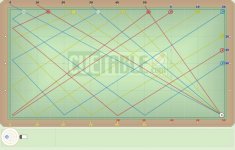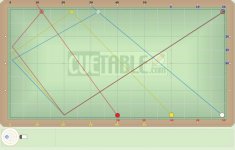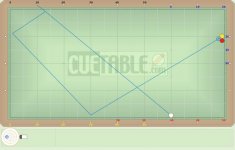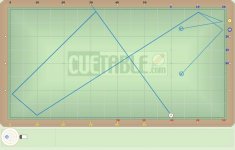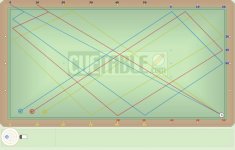First please allow me to say that I am still at intermediate beginner's level although I have been playing 3C off and on for 8 years. By no means I am an experts. It is an answer to Rasta in another thread which I thought might be educational for all. I appreciate and welcome experts to add comments.
This is an easy beginner's "Nature" system that's similar to one of Mr. Ceulemans'. There are at least 6 different types of system for different situations. This is the most basic one and probably have already been published somewhere. It was taught to me years ago by Mr. Young Lee, a very modest gentleman at Carom Cafe.
In diagram 1:
the red number at the lower right is the starting point
the blue number at the top right is the ending point
the black number at the top left is the aiming point
the yellow number at the bottom left is the 3rd cushion reference point
basic rule:
starting point - ending point = aiming point
starting point - aiming point = ending point
When setting the aiming points as variables:
50 - 0 = 50
50 -10 = 40
50 -20 = 30
50 -30 = 20
50 -40 = 10
50 -50 = 0
Notes:
A, First rail contact point and the aiming point is different, one must aim at the diamond instead of the cushion.
B, This works when CB is any where on the line between starting point and aiming point except when 1, the CB is frozen to the rail and addition top spin is applied, 2, the CB is too close to the aiming point where the CB will not reach a nature roll before contact.
C, The ending point 40 is actually 37.5 in Mr. Ceuleman's Mr. 100. Perhaps I was taught this way to remember it a little easier.
D, My friend Ira would give me a hard time (in a sense of being a strict teacher) if I ever mention about system to him. His point is: All systems are like a crutch. Once you use it, it will be hard to get rid of it. It might be easy to learn billiard by relying on them. However, they will prohibit the student from learning the finer points and being creative in the long run. As years went by I started to understand what he meant.
E, This system is a little different on a pool table. From my own experence, the pool table is about 1 to half diamond short. For more interest in this subject on a pool table, please view:
http://cuetable.com/contest/0607contest.html
http://cuetable.com/contest/index.html
It's funny how things all link up, please give it a try at our current video contest, free entry, great prizes
This is an easy beginner's "Nature" system that's similar to one of Mr. Ceulemans'. There are at least 6 different types of system for different situations. This is the most basic one and probably have already been published somewhere. It was taught to me years ago by Mr. Young Lee, a very modest gentleman at Carom Cafe.
In diagram 1:
the red number at the lower right is the starting point
the blue number at the top right is the ending point
the black number at the top left is the aiming point
the yellow number at the bottom left is the 3rd cushion reference point
basic rule:
starting point - ending point = aiming point
starting point - aiming point = ending point
When setting the aiming points as variables:
50 - 0 = 50
50 -10 = 40
50 -20 = 30
50 -30 = 20
50 -40 = 10
50 -50 = 0
Notes:
A, First rail contact point and the aiming point is different, one must aim at the diamond instead of the cushion.
B, This works when CB is any where on the line between starting point and aiming point except when 1, the CB is frozen to the rail and addition top spin is applied, 2, the CB is too close to the aiming point where the CB will not reach a nature roll before contact.
C, The ending point 40 is actually 37.5 in Mr. Ceuleman's Mr. 100. Perhaps I was taught this way to remember it a little easier.
D, My friend Ira would give me a hard time (in a sense of being a strict teacher) if I ever mention about system to him. His point is: All systems are like a crutch. Once you use it, it will be hard to get rid of it. It might be easy to learn billiard by relying on them. However, they will prohibit the student from learning the finer points and being creative in the long run. As years went by I started to understand what he meant.
E, This system is a little different on a pool table. From my own experence, the pool table is about 1 to half diamond short. For more interest in this subject on a pool table, please view:
http://cuetable.com/contest/0607contest.html
http://cuetable.com/contest/index.html
It's funny how things all link up, please give it a try at our current video contest, free entry, great prizes
Attachments
Last edited:
